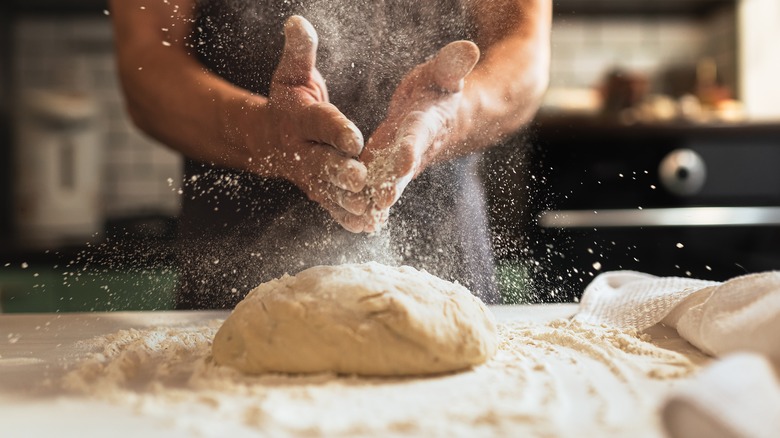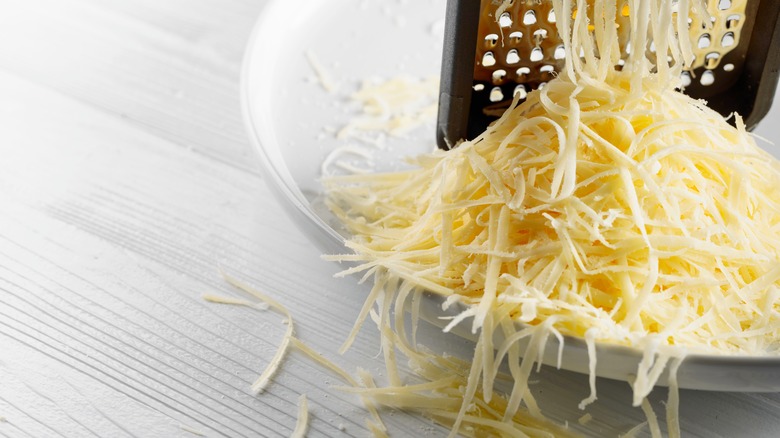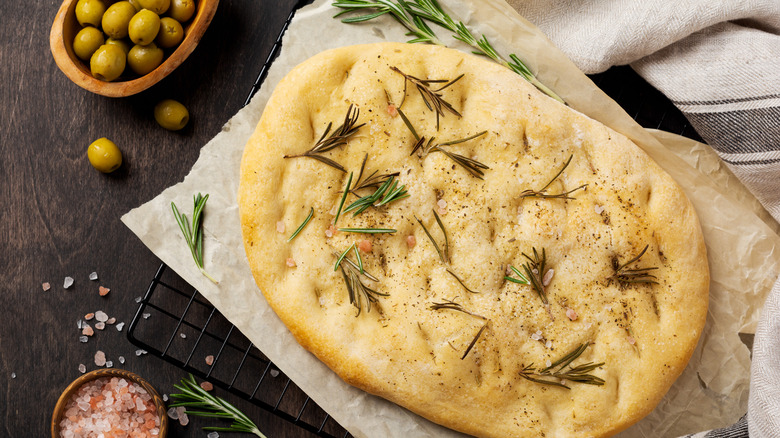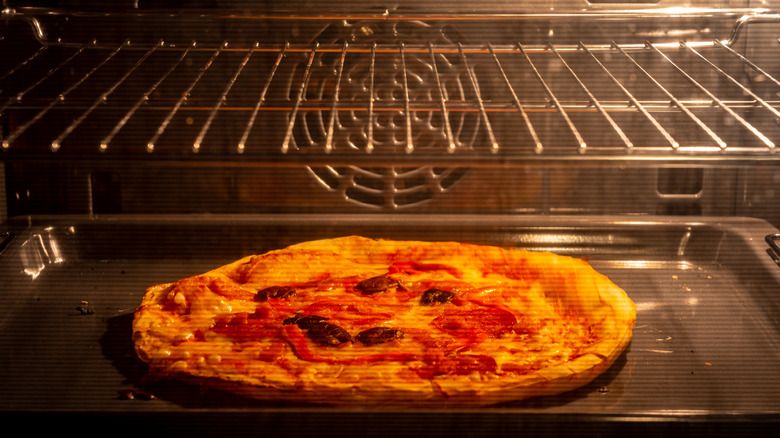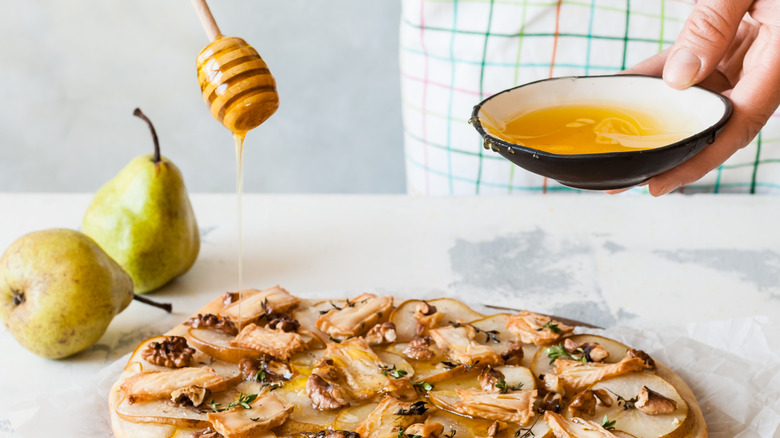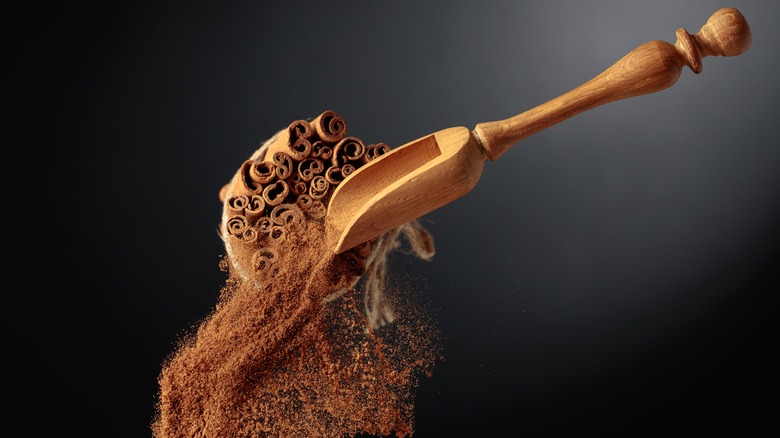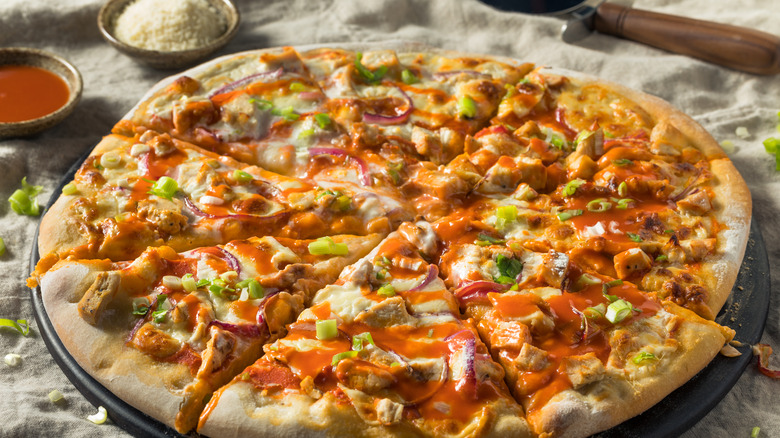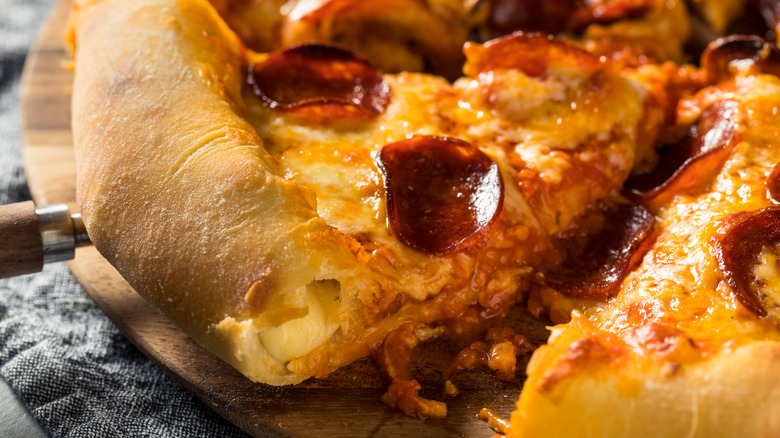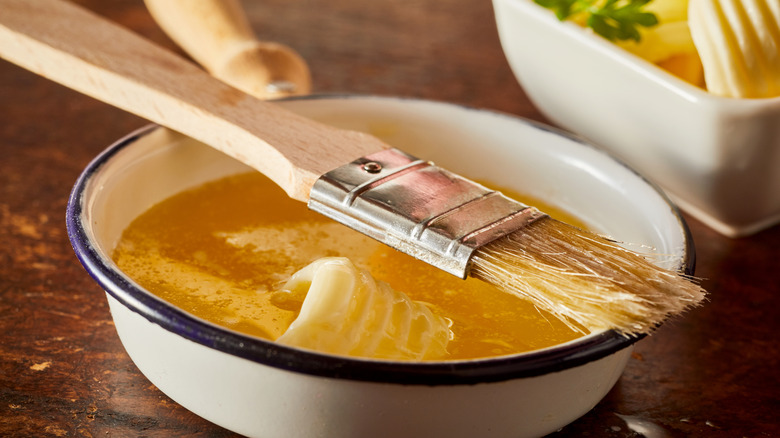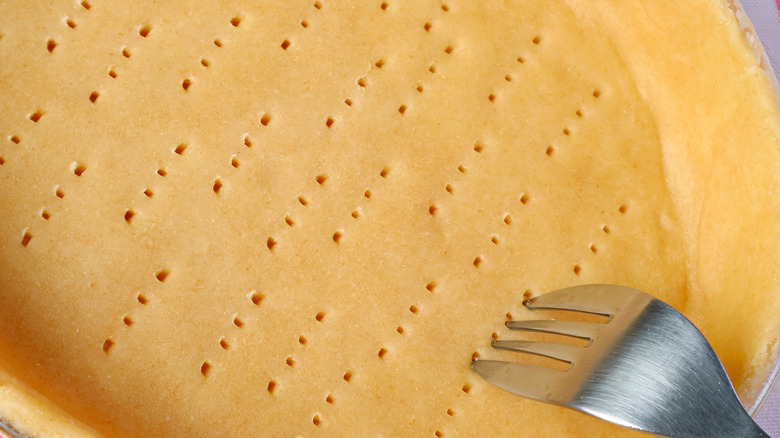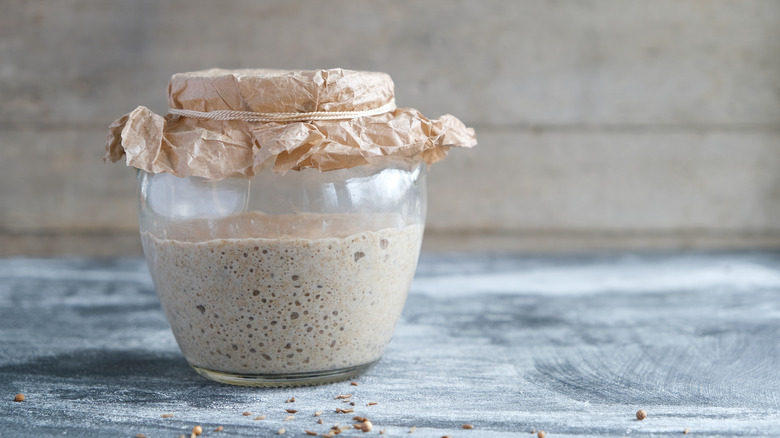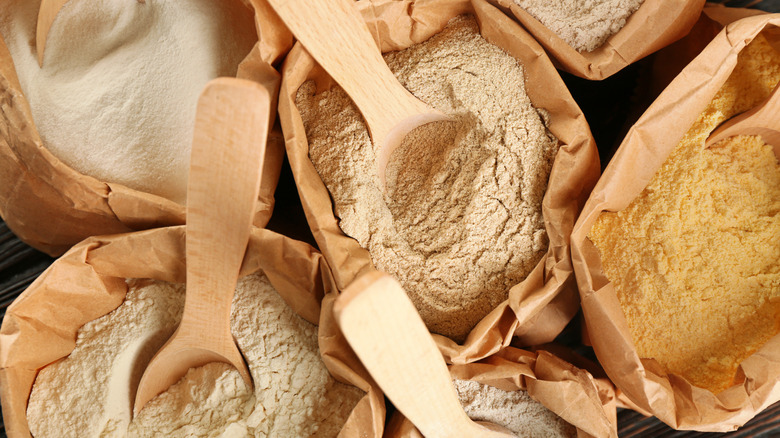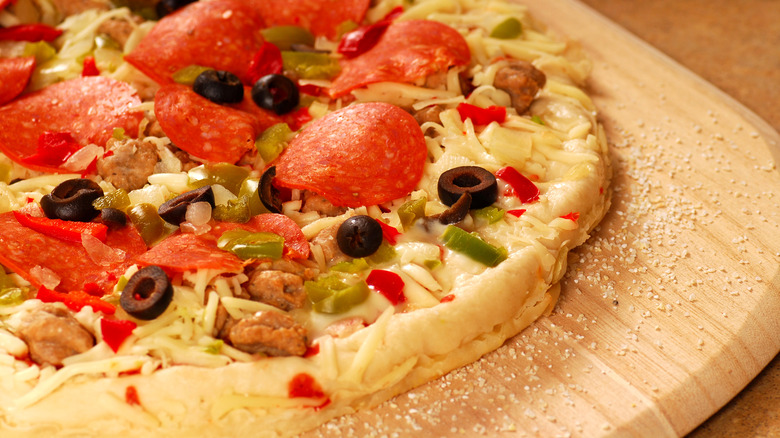12 Ways To Amp Up Your Homemade Pizza Crust
A hot and cheesy pizza is an all-time favorite for gatherings or an easy dinner; there's something for everyone with different toppings choices, it's an easy crowd-pleaser, it fills you up, and it satisfies your savory cravings. However, take-out pizza for a large group can get quite pricey and isn't exactly a healthy choice. For your next family night or average weeknight dinner, you might consider homemade crust to revamp a time-honored tradition like pizza night.
Making your own crust can be a creative option that is healthier than frozen or delivery and more affordable. According to VeryWell Fit, delivery pizza is often loaded with sodium and, overall, can be extra greasy. This is great for convenience and taste, but bad for your health. In addition, Homemade Pizza School frozen pizzas are also high in sodium and preservatives that will make you wish you'd gone for the fresh option. Homemade pizza dough is often made with just a few simple ingredients that are affordable and easy to come by.
If you're feeling overwhelmed by the idea of crafting your own healthy, inexpensive pizza dough, put your cares aside! There are plenty of easy ways to incorporate flavor, whether it's spicy or sweet, and make your dough crispier, softer, or chewier right in the comfort of your home. With just a few tips and tricks your can amp up your pizza crust and make it a new go-to favorite for dinner that won't break the bank.
1. Mix cheese into your dough
Classic pizza is layered with mozzarella cheese and occasionally sprinkled with a side of parmesan. The melty cheese pairs perfectly with the mild flavor of the dough and the tanginess of the sauce. However, there are so many options when it comes to cheese on pizza. If you take that creativity one step further and mix the cheese into your dough before it's cooked, you'll have a gooey, pull-apart cheesy crust.
When you're mixing up your homemade dough, consider sprinkling in some cheddar cheese as you knead the dough. The sharp flavor will give your dough a pinch of saltiness that might be missing. Grate the cheese and mix about a cup into your dough. This will pack some flavor but not overpower the other ingredients.
Provolone and Aged Havarti are two other types of cheese that are a great choice for pizza dough: they both have a smooth texture and a slightly sweet flavor that will pair nicely with the salt in your dough. They will also highlight any sweet toppings such as red onions or pears. This will create a perfectly crunchy crust with hints of gooey melted cheese. You might also try a few shavings of Gouda mixed in for a savory, smoky flavor. The crust alone will be a satisfying snack. Finely grate these cheeses and knead them into your dough. Be sure to work the cheese thoroughly into the dough and add some parchment paper under your crust while cooking to avoid sticking.
2. Don't forget to season your crust
Making homemade pizza crust is often about following a simple recipe. However, it's the extra care and detail that takes any recipe to a higher level. You could keep your dough simple and season it with salt, or you can be creative and embrace the way spices and seasonings can pack your pizza with complex flavors. Choose your seasonings and mix them thoroughly into your dry ingredients before you add the wet ingredients and start kneading. This will help blend the spices evenly and subtly throughout the dough. If you are looking for a slightly more impactful punch of flavor, mix your spices, and roll out your dough. Once the dough is ready, brush on some olive oil and rub your seasonings into the dough lightly, similar to a meat rub. You can even bake the crust for a few minutes before adding your sauce and toppings to really toast the spices and draw out their flavor.
When it comes to pizza, the classic Italian seasoning of salt, garlic powder, basil, and oregano can really go a long way. These spices will mix seamlessly with those in your sauce. If you're feeling more adventurous you can tie in your seasonings with your toppings. Add some thyme to pair with sausage and red onions. Or knead in rosemary if you want to slice some pears and Gorgonzola cheese on top.
3. Use the broiler to get an extra crispy crunch
There are a hundred different ways you can cook your pizza crust. You can break out the pizza stone, throw open the grill, bake it in the oven, or pop it in the air fryer. If not all these options are available to you, one trick to consider is utilizing the broiler in your oven.
Begin by baking or cooking your pizza crust however you choose. Ensure that the crust is cooked in the middle — it can get soggy from all the built-up moisture — and then crank up the heat on your oven. The broiler is often set to 500 degrees, which means it can burn your pizza in a hot minute. Aim to cook your pizza for two to three minutes to start. Always set a timer, and never walk away from your pizza under the broiler. The extra heat will add a crispy crunch to your crust that's often found on New York-style pizzas from a pizza oven. An added benefit is that this technique will cook your pizza toppings in just a few minutes. It can brown up your cheese and crisp up your pepperoni to perfection.
The broiler is often located on the top of the stove, but not always, so be sure to double-check. You could cook extra thin-crust pizzas entirely under the broiler, but this isn't a great technique if you're making a thick crust.
4. Drizzle hot honey on your crust
Pizza may be a common item on the menu, but that doesn't mean you have to stick with traditional toppings to enjoy this filling meal. Taking a sweeter route with your toppings and seasonings — like hot honey — can yield great results. Pair with a side salad or roasted veggies to add a contrasting savory kick.
You don't want to over-sweeten your pizza, so it's best to keep the flavors in your crust subtle. Once your dough is rolled out, spread hot honey over the crust in a thin even layer, or in a swirling drizzle that will add a sweet surprise to every bite. Bake your dough for a few minutes before adding the toppings. This will add a nice crunch, and the honey will become a glaze that elevates your dough.
Crust drizzled in honey doesn't mean ultra-sweet. In fact, honey pairs nicely with smooth, smoky cheeses like gouda or provolone. The sweet flavor can also create a nice contrast to bitter greens such as arugula or kale. Nuts on pizza might sound a little crazy, but if you're feeling adventurous, try a pine nut, feta, and honey combo. The honey in the crust can also go nicely with walnuts. In addition, you can go light on the honey and still bring out the natural sweetness of fruits and veggies, such as pears or roots. Mix all of the best pairings together with a honey-pear pizza featuring gouda cheese and basil.
5. Transform your pizza into a dessert
Pizza is a great option for dinner, but why not translate this classic meal into a simple yet exciting dessert? Pizza dough typically offers a mild flavor that can be the perfect canvas for many flavors, including sugar. The simple combination of cinnamon and brown sugar can completely transform your dough from savory to sweet.
There are a few methods for incorporating these ingredients. Consider adding a spoonful of cinnamon and a quarter cup of brown or white sugar — depending on how sweet you want your dough to be — to your dry ingredients before kneading. Or you can roll your dough out and sprinkle the mixture over the top prior to baking. For an extra crunchy, sweet treat, keep your dough thin so that it can crisp up in the oven.
However, thicker dough with cinnamon and sugar can also be a nice fluffy base for your sweet toppings. This small detail can go a long way and really round out your dessert. Layer on some freshly sliced fruit for a hearty, delectable treat. You can also add syrup or chocolate spread as a replacement for sauce on your dessert pizza. Then you're free to get creative with crushed cookies, marshmallows, strawberries, and even whipped cream on top. Add a pinch of cinnamon to your toppings as well to bring out the complex flavors of the already slightly toasted cinnamon in your crust.
6. Pick a theme and season your crust accordingly
Nothing really says fun and carefree like pizza night! And there are endless ways to get creative. If you want to mix up your weekly pizza night, start with the base and build from there. Choose a theme for your meal and embrace the many flavors and seasonings available.
Feeling a little spicy? Try a Mexican or nacho-inspired pizza. Add cumin and a pinch of paprika to your crust, either before rolling it out or after. For a truly simple upgrade, mix a packet of taco seasoning into your dry ingredients. You can add everything from salsa and cheese to jalapenos and sour cream on top.
If you have leftover shredded chicken, try chicken parm or buffalo chicken pizza. Season your crust with oregano and basil for an Italian taste. Or add some spice with crushed red peppers and a splash of buffalo sauce mixed into your dough. For a veggie pizza, you can add a bit of balsamic vinaigrette to your dough. Remember, if you are adding extra liquid, cut back slightly on the water in your recipe to avoid making dough that is too wet. You can also baste your pizza dough once it has been rolled out. Slather on some olive oil and balsamic vinegar before cooking and the sticky glaze will bring your taste buds to life.
7. Stuff your pizza crust for even more flavor
Pizza dough might not seem like the exciting part of your meal when you consider all of the toppings to choose from. However, the dough is the filling, satisfying portion of pizza that can make or break your dinner. Filling or stuffing your crust can be another easy and adventurous way to beef up your meal. Cheese-filled crust sounds like a no-brainer but there are endless options to choose from.
A stuffed crust tends to work better with thick-crust pizzas. The longer cook time allows the filling to be thoroughly cooked before the crust burns. An easy trick to use string cheese or long strips of sliced cheese. Roll out your dough and make it bigger than the intended pizza pan. Layer the cheese around the edges and gently roll the dough over. If the crust isn't staying closed, use a fork to pinch the seams together or a bit of water to make the dough stickier.
Try ricotta cheese for a unique twist on stuffed crust. Mix in your favorite herbs and spices and add a ring of cheese around your crust. The soft texture of the ricotta will melt perfectly inside your crust and its creamy taste will be unexpected. Going beyond cheese, you can also stuff your crust with different proteins. Pepperoni and sausage can be an exciting surprise. The natural oil from the meat will be absorbed by the dough and creates a savory, flavorful bite.
8. Brush your dough with butter instead of olive oil
If you are pre-cooking your crust for added crunch and more evenly cooked dough, it's a great idea to baste or brush your rolled-out dough with a bit of melted butter. Pop a tablespoon of butter in the microwave for about thirty seconds and either drizzle and use a the back of a spoon to spread the butter around or dig out your basting brush for a more thorough layer. This extra step is so simple, but it will add a punch of flavor and a crispy texture to your crust.
Other types of oil, as well as butter, can help achieve that delicious golden-brown look to your crust; however, the creamy, salty, and slightly sweet taste of butter will go fabulously with your dough and help tie in the flavor of your toppings. Butter, unsalted or salted, often has a milder taste than olive oil, and can make a fantastic base for your dessert pizzas. Butter helps transform your pizza dough into more of a pastry-like crust that goes great with chocolate, fruit, and other sweet toppings. Consider using butter for your breakfast pizza as well. The taste of butter will work well with eggs, red onions, and breakfast sausage, much like a flaky, buttery quiche crust.
9. Dock your dough
Pizza dough usually involves a very simple recipe; however, it's important to remember that dough is baking and baking is a science. Small details can make a big difference in the final product. When it comes to pizza dough, small mistakes can leave it too thin, too thick, or too soggy, among other pitfalls.
One helpful technique for avoiding these common problems and making the perfect pizza crust is docking your dough. Docking, put in simple terms, is poking small holes into your dough before cooking it. These holes allow some of the moisture to escape while the dough is cooking. If too much moisture from the heat is trapped beneath the crust it could create an unevenly cooked crust. If the center of your pizza often comes out gooey and doesn't quite get that crunch, you might want to try docking.
There are special tools that you can buy to dock your dough, but a fork will work just as well. Once your dough is rolled out and either ready for the oven or ready for toppings, use the prongs of the fork to poke small holes all the way through the dough. The crispier you want your dough to be, the more holes you should create. In addition, pre-cooking your dough for just a few minutes before adding your toppings can help cook the dough evenly and you can prevent a soggy center that is difficult to cook and eat.
10. Put your sourdough starter to use
If you jumped on the sourdough bandwagon during the pandemic or are a bit more adventurous in the kitchen then you might have a sourdough starter in one of your pantries. Sourdough bread can be easier to digest and it's full of complex flavors. Don't be deterred by the word sour. You can use a sourdough starter for pizza dough without creating a powerful sour taste. A mild sour flavor actually tends to work well with tangy tomato sauce and light fresh cheeses.
Sourdough starter can be mixed with different types of flour, all of which may impact your dough. If you're new to sourdough starters, we recommend finding a well-researched recipe and sticking to it. All of the factors involved in making sourdough bread have different effects on the taste and texture of your dough, so it's best for beginners to work with tried-and-true recipes.
Typically, most recipes call for about ten to twenty percent of the starter in your recipe. If used correctly, the sourdough starter can give your dough a layered flavor that is more exciting than regular dough. In addition, pizza can often feel like a heavy meal, especially for anyone sensitive to gluten. A sourdough starter is an excellent way to avoid too much gluten and digestion issues.
11. Use 00 flour to create a light, chewy dough
The very delicate process of baking can depend greatly on the ingredients you use. The smallest details in quality and type can alter the reactions during backing, causing your end result to vary. For example, classic Neapolitan pizza is beloved for its crispy, flaky outside, but soft and doughy inside. That balance is achieved with very specific ingredients. The secret is 00 or double-zero flour.
Double-zero flour is commonly used in Italian cooking. The name refers to how finely the wheat is ground and the overall texture. 00 flour is ground into a very fine powder that almost resembles powdered sugar and requires less water, which makes for perfect, flexible dough for kneading. Although you might not notice a huge difference, it can take your cooking to the next level.
00 flour is made from wheat that contains less gluten than the wheat used to make all purpose flour. Flours that contain more gluten are often chewier, which can be excellent for baking cookies and cakes, but they lack that soft, airy quality that 00 flour offers. Although this type of flour is often available in most grocery stores, you can also use bread flour for pizza crust, which is the closest in comparison.
12. Add cornmeal to your crust
If you've ordered pizza from a restaurant lately you might notice the crumbly, small bits that remain on your plate or on the pizza platter after you're done eating. Contrary to what you might believe, this isn't flour or small chunks of crust — it's actually cornmeal. Pizza makers often sprinkle a handful of cornmeal onto the surface where they roll and stretch the dough.
Cornmeal not only adds a delightful crunch to the bottom of your pizza crust, but it also prevents the dough from sticking to the table as it's stretched and pulled, or as it cooks in the baking pan. When it comes to taste, both yellow and white cornmeal will do. The added saltiness will give your dough a more complex flavor, which is another extra step to elevate your meal. However, when it comes to texture, you should be more precise when buying your cornmeal. Medium coarse cornmeal will prevent your dough from sticking and add the perfect hint of crunch to your crust without overwhelming the dough with a gritty texture. Avoid finely ground cornmeal, as it will defeat the purpose and your dough will stick.
